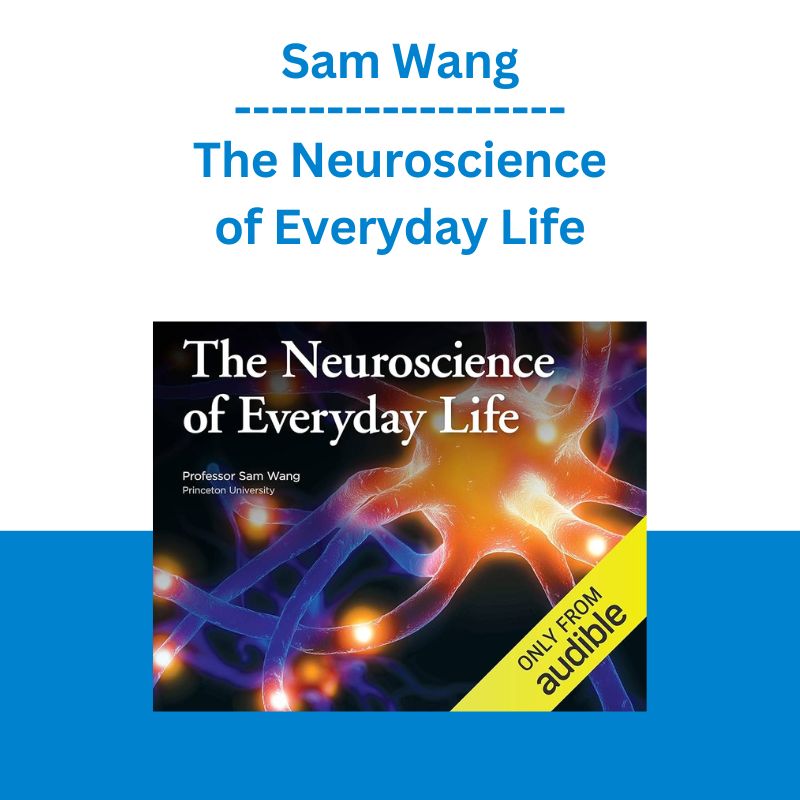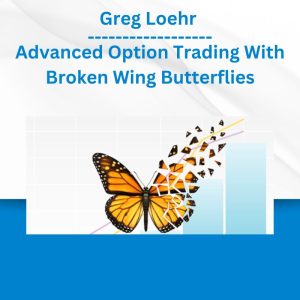*** Proof of Product ***
Exploring the Essential Features of “Sam Wang – The Neuroscience of Everyday Life”
The Neuroscience of Everyday Life
Discover what the exciting field of neuroscience reveals about how the intricate inner workings of the human brain produce all the experiences of daily life.
LECTURE
Trailer
01:What Is Neuroscience?
Launch your investigation into neuroscience, a field that can explain many aspects of human behavior. After taking a brief tour of the brain, preview three classic problems on which neuroscience has shed new light—on the perception of red, dreaming, and early development.
31 min
02:How Do Neuroscientists Study the Brain?
Professor Wang introduces the key approaches used by neuroscientists, each of which gives a different kind of evidence about the brain. Look at what neuroscience has to say about two common beliefs: alcohol kills neurons, and classical music makes babies smarter.
25 min
03:Evolution, Energetics, and the 10% Myth
Analyze how brains are similar across a wide range of species and how energy use in the brain allows the imaging of cognitive function. Also investigate two persistent myths about the brain: that it works like a computer, and that we use only about 10% of its capacity.
27 min
04:Neurons and Synapses
The brain operates on just 15 watts of power—about the power of a refrigerator light bulb. See how this current translates into all the phenomena of the brain by examining the chemical pathways that neurons use to communicate across synapses.
26 min
05:Neurotransmitters and Drugs
Neurons “talk” to each other through neurotransmitters. Study how these chemicals act on special receptor molecules and how drugs can alter this system. The most abundant neurotransmitters are glutamate, GABA, and glycine. Supplementing these, the biogenic amines norepinephrine, dopamine, and serotonin play important roles in attention, reward, and mood.
32 min
06:Juicing the Brain
How do drugs work on the brain? Why are some chemicals addictive and others not? Explore the neuroscience of an array of psychoactive substances, including caffeine, marijuana, cocaine, amphetamines, nicotine, opiates, L-dopa, and Ritalin. Each works by imitating or altering the action of neurotransmitters.
29 min
07:Coming to Your Senses
Trace the origins of your senses of touch, taste, smell, hearing, and vision, each of which results from a cascade of events at the molecular level. Discussing many examples, Professor Wang looks at why MSG tastes so good, loud music causes hearing loss, and men are more likely to be color blind than women.
33 min
08:Perception and Your Brain’s Little Lies
At any given moment, your brain is probably lying to you. Although you think you perceive the world directly, your brain analyzes stimuli in ways that may not reflect reality. Experience a startling example with the “stepping feet” illusion.
28 min
09:Pain-All in Your Head?
Pain is a perception generated entirely within the brain, yet it announces that something is drastically wrong. Learn that the intensity of pain depends on the context of an injury. Also investigate how pain responds to different drugs, meditation, and acupuncture.
30 min
10:Decisions-Your Brain’s Secret Ballot
When making decisions, are you a maximizer or a satisficer? The first seeks the best possible outcome from an array of options; the second is satisfied with a swift decision from limited choices. Studies show that our brains often make up our minds before we are aware of it.
29 min
11:Reward, Adaptation, and Addiction
Reward and addiction are two sides of the same coin. Examine how dopamine-secreting neurons reinforce behaviors that are beneficial to the organism. Unfortunately, certain drugs target these same neurons and put the reward system into overdrive, resulting in physical addiction.
26 min
12:The Many Forms of Memory
Chart the famous case of H. M., who lost the ability to form new memories after an operation for epilepsy. The tragic outcome sheds light on the location of different components of memory. Also probe the connection between declarative memory and our ability as animals to find our way in the world.
31 min
13:Quirks of Memory
Memory evolved to deal with fear, spatial navigation, and factual knowledge. It can be rewritten and strengthened, but also altered in the rewriting. Study the quirks of memory that show up in source amnesia, post-traumatic stress disorder, and the formation of false beliefs.
30 min
14:Learning, Studying, and Sleep
Learn what it means to learn at the cellular level by focusing on two key principles: cells that fire together wire together; and out of sync, lose your link. Then get tips on how to study most effectively based on what neuroscience has discovered about learning. Finally, investigate the role of sleep in consolidating new knowledge.
29 min
15:Willpower and Mental Work
Willpower draws on a finite mental resource. Look into the famous “marshmallow study” with four-year-olds, which showed the far-reaching effects of childhood self-control on later life. Next, learn strategies for harnessing willpower most effectively, including the trick of brushing your teeth with your nondominant hand.
30 min
16:Work, Play, and Stress
You don’t want to be too relaxed. Study the role of stress as an adaptation to best respond to uncertainty or danger. Stress also has an intimate relationship to play. Trace the stress response from its source and learn the detrimental effects of chronic stress on the body and brain.
30 min
17:Biological Timekeepers and Jet Lag
Anyone who travels quickly across several time zones is tinkering with the brain’s circadian clock. Explore this biological timekeeper, which is located in the hypothalamus and takes its cues from light entering the eyes—a mechanism that suggests a strategy for combating jet lag.
33 min
18:The Hidden Talents of Infants
Begin a series of lectures on the developing brain by focusing on infants. Around three months of age, babies are learning to acquire information in five ways: by noticing rare events, reasoning from cause to effect, distinguishing objects from agents, categorizing, and discarding irrelevant information.
28 min
19:The Mozart Myth and Active Learning
The Mozart myth is the widespread belief that playing classical music to babies increases their intelligence. Discover what is really going on in young minds, which need only normal experiences to thrive. Professor Wang offers advice on the best strategy for nurturing learning in children.
30 min
20:Childhood and Adolescence
The most rapid changes in the brain happen before the age of six, but growth and maturation continue all the way through adolescence and beyond. Track the nature of this growth and how it explains the propensity of adolescents for risk-taking, hyperactivity, and short attention spans.
29 min
21:Handedness-Sports, Speech, and Presidents
Why are humans so overwhelmingly right-handed? What does this tell us about left-handed people? Look into the possible sources of this trait and the reason lefties excel at some sports but not others. Intriguingly, a possible connection with language processing may explain why several recent U.S. presidents have been left-handed.
31 min
22:Reaching the Top of the Mountain-Aging
The brain continues to change throughout life. Assess these transformations at the level of neurons and see how they affect large-scale traits such as memory, verbal comprehension, and emotional control; the last two actually improve with age. Also consider debilitating changes such as Alzheimer’s disease and stroke.
28 min
23:“Brain Exercise” and Real Exercise
How useful are brain-training exercises such as Sudoku puzzles? Discover that interpreting the ambiguous research results is a brain exercise in itself! Compare the limited benefits from these activities with the more robust cognitive effects of physical exercise, in which what helps the heart also boosts the mind.
29 min
24:Animal and Human Personality
Starting a series of lectures on individual differences in brains, probe personality in humans and animals. Personality is a complex of traits that are partly inherited. On the other hand, shyness and anxiety are two attributes that can sometimes be reversed through early intervention.
32 min
25:Intelligence, Genes, and Environment
Fluid intelligence is the ability to reason through an unfamiliar problem. Discover that there is a strong inherited component to this ability. However, under conditions of deprivation, fluid intelligence is mostly environmentally determined. Also see how intelligence test performance can be influenced by prior expectations on the part of the test taker.
30 min
26:The Weather in Your Brain-Emotions
Investigate the essential function of emotions and where they originate. One emotional phenomenon—blushing—raises an intriguing question: Is it the effect of embarrassment or the cause, and what does this tell us about other emotions? Finally, look at the link between disgust and the moral sense.
33 min
27:Fear, Loathing, and Anger
Probe deeply into primal emotions that originate in the brain’s hippocampus, hypothalamus, and amygdala: namely anger, rage, fear, and anxiety. Evolution has equipped us to learn a specific fear after only a single experience, but unlearning the same fear requires prolonged conditioning.
30 min
28:From Weather to Climate-Mood
Mood is to emotion as climate is to weather; that is, mood is a long-lasting phenomenon. Delve into the nature of moods, which in their most extreme forms constitute major psychiatric problems. Finally, examine treatments for depression and other mood disorders.
31 min
29:The Social Brain, Empathy, and Autism
Whether you realize it or not, as you watch these lectures you are deploying a theory of mind about Professor Wang’s thoughts and motivations. Look more closely at this remarkable faculty—the social brain—by investigating a neurological disorder where it appears to be absent: autism.
29 min
30:Mars and Venus-Men’s and Women’s Brains
While the brains of other animals often show striking differences between the sexes, male and female humans have remarkably similar brains. Learn the nature of our hormone-driven differences, for example, in toy preference, spatial reasoning, and susceptibility to certain neurological disorders.
33 min
31:Sex, Love, and Bonds for Life
Trace the source of human sexual behavior to the hypothalamus, where secretion of the hormones vasopressin and oxytocin play a role in the full range of sexual expression—from love and attachment to mating, birth, and bonding between mother and infant.
28 min
32:Math and Other Evolutionary Curiosities
Turn to two evolutionary curiosities that are uniquely human: humor and mathematics. Neither seems to provide a survival advantage through natural selection. Or do they? Professor Wang looks at the origins and function of humor. Then he searches for the roots of our mathematical ability.
33 min
33:Consciousness and Free Will
Investigate two big ideas where neuroscience intersects philosophy: consciousness and free will. In exploring the many facets of consciousness, discover that we may be overrating it as a cause of behavior. Free will is even more difficult to evaluate and raises the question: Are we agents or are we robots?
32 min
34:Near-Death and Other Extreme Experiences
Plumb the depths of extreme experiences to learn what neuroscience has to say about near-death visions, out-of-body experiences, haunted houses, and other paranormal phenomena. In each case, the brain appears to be trying to piece together a story from incomplete or highly unusual data.
28 min
35:Spirituality and Religion
How does the human brain lead to spirituality and religion? Chart the synchronous firing of neurons that accompanies deep meditative states. Then draw on what you have learned in the course to explore the role of the brain in finding transcendent meaning in the world through religion.
31 min
36:Happiness and Other Research Opportunities
Conclude the course by exploring a mysterious brain function that looms large for practically everybody: happiness. Finally, survey some of the new research trends in neuroscience that are leading to a deeper understanding of the everyday wonders of the human brain.
34 min
DETAILS
Overview
Discover what the exciting field of neuroscience reveals about how the intricate inner workings of the human brain produce all the experiences of daily life. The Neuroscience of Everyday Life, crafted by distinguished neuroscientist and Princeton University Professor Sam Wang, covers a remarkable range of subjects in 36 richly detailed lectures. You’ll explore the brain under stress and in love, learning, sleeping, thinking, hallucinating, and just looking around. Assuming no background in science, Professor Wang’s insightful approach makes this course a joy for people who want to know how their brains work every single day of their lives.
About
Sam Wang
As a neuroscience researcher, I study how the brain is responsible for our experiences and thoughts. In this course, I wanted to relate that fact to people’s everyday lives-from sensation to dreams to autism to Alzheimer’s.
Dr. Sam Wang is Associate Professor of Molecular Biology and Neuroscience at Princeton University. He earned his B.S. in Physics from the California Institute of Technology and his Ph.D. in Neurosciences from the Stanford University School of Medicine. Dr. Wang is a well-known researcher in the field of neuroscience and has published more than 50 papers in peer-reviewed journals. His work includes the discovery that learning mechanisms can act like all-or-none switches, and that bird and mammalian brains share similar architectures for generating complex social relations. Dr. Wang is also the coauthor of the best-selling popular book, Welcome to Your Brain: Why You Lose Your Car Keys But Never Forget How to Drive and Other Puzzles of Everyday Life. The book has been translated into more than 20 languages and received the AAAS/Subaru Science Book of the Year Award in the Young Adult category. Professor Wang has been widely honored for his scholarship and his advances in neuroscience. He has been the recipient of an Alfred P. Sloan Fellowship, the Rita Allen Foundation Young Scholars Fellowship, a Distinguished Young Investigator Award from the W. M. Keck Foundation, and a CAREER award from the National Science Foundation. He was also selected by the American Association for the Advancement of Science as a Congressional Science and Engineering Fellow, and he served on the staff of the U.S. Senate Committee on Labor and Human Resources.
REVIEWS
Glenn C
Outstanding series of lectures
I have been taking a number of courses on neuroscience and this is at or near the top. Graphics are outstanding, video is essential. I read some of the criticisms and writing this to offset their poor ratings as I think they unfair. Many seem to relish their ability to disagree with substance as if that makes them intelligent. Assume they are right that there are flaws (none of the courses disagree), to trash the series with a low rating is childish or not intellectually objective to try and inform potential listeners. I for one found his lectures to be outstanding and highly recommend watching. I found the content on influence of expectations on its own to be educational. I also found information to help me understand addictions others have to be critical so not to judge their harmful behaviors.
Awakening
Excellent courses
The lectures are groundbreaking and life-changing. They helped me understand the mind scientifically and cohesively, and answered many of my confusions and questions about how the mind works. His approach is very ingenious and profound. I’m deeply grateful for his generous teaching and contribution to humanity.
Please see the full list of alternative group-buy courses available here: https://lunacourse.com/shop/









